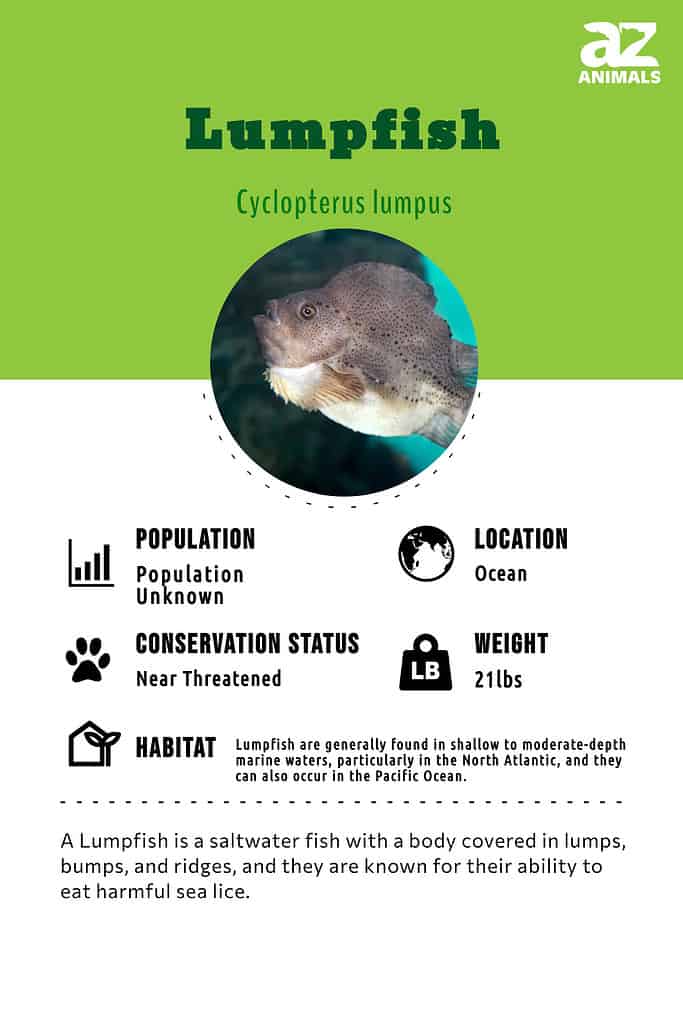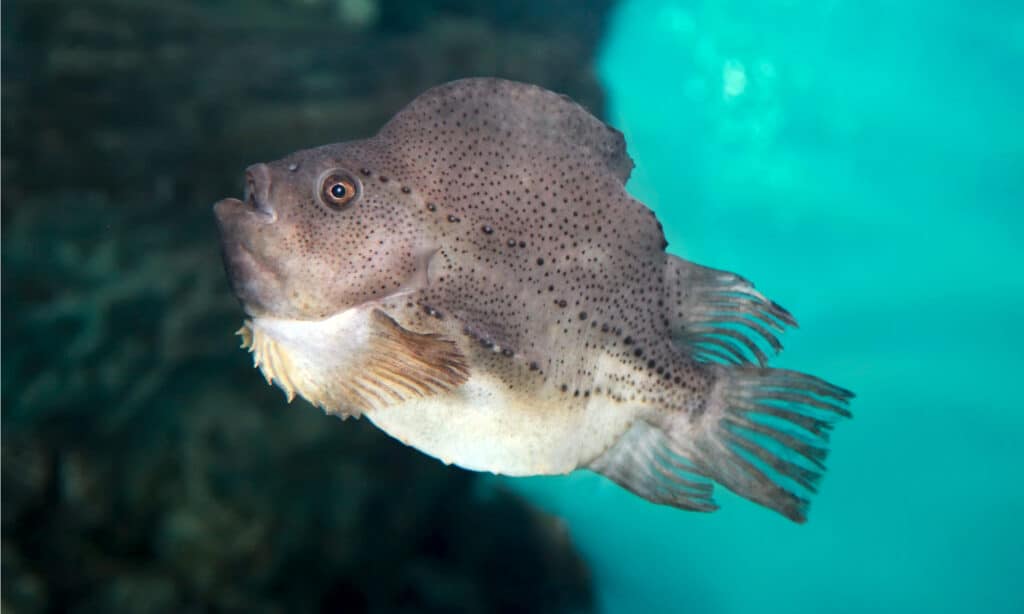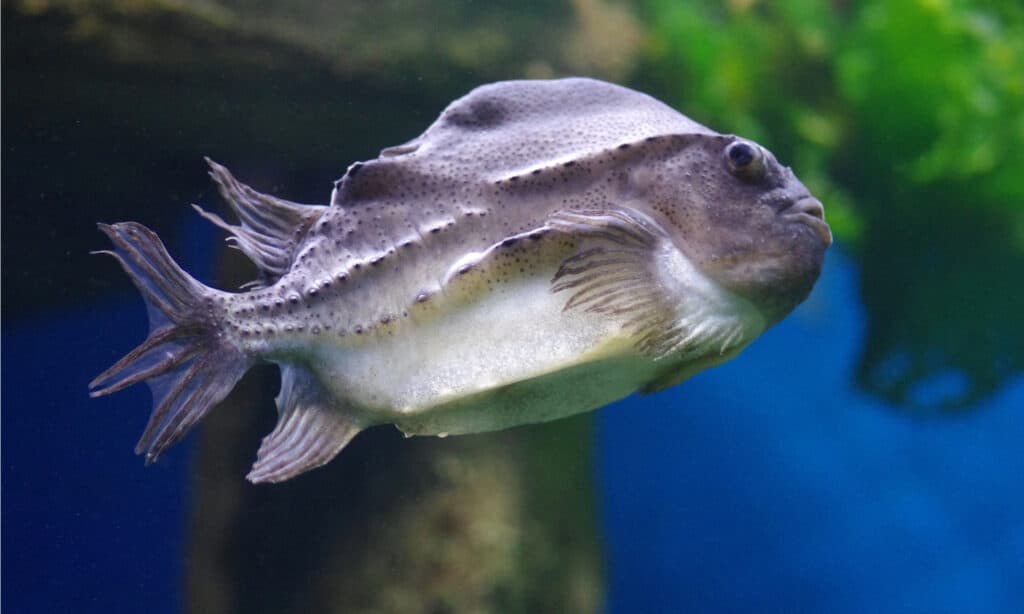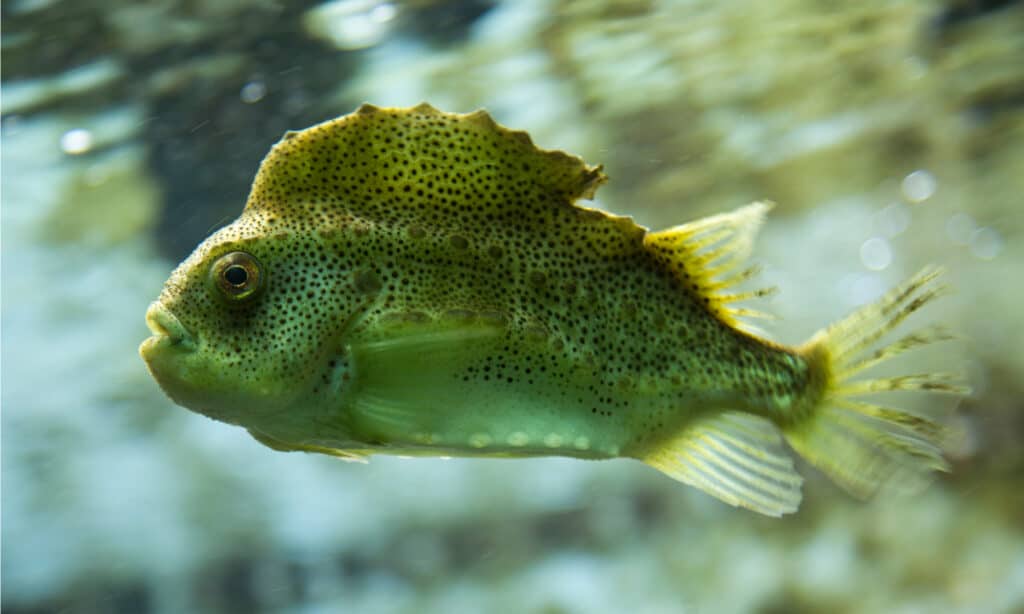Lumpfish
Cyclopterus lumpus
The lumpfish have sticky suction cups on their fins
Advertisement
Lumpfish Scientific Classification
- Kingdom
- Animalia
- Phylum
- Chordata
- Class
- Actinopterygii
- Order
- Scorpaeniformes
- Family
- Cyclopteridae
- Genus
- Cyclopterus
- Scientific Name
- Cyclopterus lumpus
Read our Complete Guide to Classification of Animals.
Lumpfish Conservation Status
Lumpfish Facts
- Prey
- Crustaceans, worms, jellyfish, herring, sand lance, and more
- Group Behavior
- Solitary
- Fun Fact
- The lumpfish have sticky suction cups on their fins
- Estimated Population Size
- Unknown
- Biggest Threat
- Overfishing
- Most Distinctive Feature
- The lumpy, gelatinous flesh
- Other Name(s)
- Lumpsuckers
- Gestation Period
- 1-2 months
- Optimum pH Level
- Unknown
- Habitat
- Atlantic and Pacific Oceans
- Predators
- Skates, seals, sperm whales, sharks, and orcas
- Diet
- Carnivore
- Type
- Ray-finned fish
- Common Name
- Lumpfish
- Number Of Species
- 30
View all of the Lumpfish images!

Lumpfish have suction cups on their fins to attach to various surfaces.
The lumpfish, also known as the lumpsucker, is a family of marine fish that come in many different colors, including blue, brown, and black. There are 30 recognized species spread all over the globe. Their lumpy, uneven, gelatinous skin and balloon-shaped body give them a truly bizarre appearance. While interesting to observe, they generally do not make good aquarium fish as human pets. Unfortunately, there is still a lot we do not understand about their behavior and ecology in the wild.
4 Lumpfish Facts

Salmon farmers often find lumpfish to be beneficial creatures as they have a reputation for feeding on sea lice, which can negatively impact the health of salmon.
©Tatiana Belova/Shutterstock.com
- Lumpfish can migrate throughout the year in response to changing environmental conditions. In the winter, they feed in cold waters. In the summer, they move toward shallow waters to breed.
- Lumpfish are considered to be poor swimmers. They generally stay close to the bottom of the ocean.
- The Pacific spiny lumpfish, also known as the Japanese spiny lumpfish, is a popular exhibit in Japan for parties and special occasions. In one such novelty exhibit found in Tokyo, the Japanese spiny was attached to balloons in the water.
- Lumpfish are very useful animals for salmon farmers because they’re known to eat harmful sea lice that affect the health of the salmon.
Classification and Scientific Name

The lumpfish family is scientifically referred to as Cycloptridae.
©alexkoral/Shutterstock.com
The scientific name of the lumpfish family is Cycloptridae. This is derived from the combination of two Greek words: kyklos, meaning circle, and pteryx, meaning wing or fin. This refers to the circle-shaped suction discs on their fins. Eight different genera are currently recognized within this family.
Evolution and Origins
Lumpfish, also known as Cyclopterus lumpus, are a type of marine fish that are typically found in the North Atlantic but can sometimes be found as far south as the Chesapeake Bay, with a skin-covered fin that forms a high crest on their backs, and three rows of bony protrusions on their sides.
The lumpfish are a type of saltwater fish that can be found in both the eastern and western Atlantic, ranging from Spitsbergen in the north to Portugal in the south and from Newfoundland and Labrador in the west to New Jersey in the east, as well as off the coasts of Iceland and Greenland.
The lumpfish is appropriately named due to its variety of lumps, ridges, and bumps, and its skin is adorned with fleshy knobs and spots.
Different Types
- Aptocyclus ventricosus
- Cyclopsis tentacularis
- Cyclopteropsis bergi
- Cyclopteropsis brashnikowi
- Cyclopteropsis inarmatus
- Cyclopteropsis jordani
- Cyclopteropsis lindbergi
- Cyclopteropsis mcalpini
- Cyclopteropsis popovi
- Cyclopterus lumpus
- Eumicrotremus andriashevi
- Eumicrotremus asperrimus
- Eumicrotremus awae
- Eumicrotremus derjugini
- Eumicrotremus eggvinii
- Eumicrotremus gyrinops
- Eumicrotremus jindoensis
- Eumicrotremus orbis
- Eumicrotremus pacificus
- Eumicrotremus phrynoides
- Eumicrotremus schmidti
- Eumicrotremus spinosus
- Eumicrotremus taranetzi
- Eumicrotremus tartaricus
- Eumicrotremus terraenovae
- Eumicrotremus uenoi
- Georgimarinus barbatus
- Lethotremus muticus
- Microancathus fedorovi
- Microancathus tokranovi
- Proeumicrotremus soldatovi
Appearance
The lumpfish have round, balloon-shaped bodies with big eyes and fan-like fins. Their scale-less skin, which is covered in bumps, ridges, and fleshy knobs, has been described as leathery and bumpy. Their handy suction discs on their pelvic fins enable them to attach to different surfaces in the face of strong currents.
Depending on the species, the lumpfish can vary in size anywhere from 1 inch to 24 inches. Females are generally larger than males, but otherwise, they are difficult to tell apart from each other. Lumpfish generally exhibit drab colors, including brown, blue, black, and gray, which can change as they age, but males tend to turn bright colors when attempting to attract a mate.
Distribution, Population, and Habitat

Lumpfish can be commonly found in the Atlantic and Pacific Oceans, typically in shallow waters up to a depth of approximately 3,000 feet.
©Natalia Sidorova/Shutterstock.com
Lumpfish are generally found in shallower marine waters throughout the Atlantic and Pacific Oceans up to a depth of nearly 3,000 feet. The greatest number of species can be found in the northern Atlantic. They are found near the bottom of the ocean, where their subdued colors provide effective camouflage against potential predators.
Very little is known about the population numbers of the lumpfish. In fact, the vast majority of species have not yet been evaluated, but it is considered near threatened by the IUCN Redlist.
A species, known simply by its scientific name of Georgimarinus barbatus, has been evaluated, and even that is considered to be data deficient (meaning we don’t have enough population data about them). The greatest threats to their existence include overfishing, habitat change, and large-scale disruptions due to the exploration of undersea oil and gas.
Predators and Prey
The lumpfish are primarily carnivorous predators. They will eat almost anything they can find at the bottom of the ocean.
What eats the lumpfish?
The lumpfish is preyed upon by numerous marine animals, including skates, seals, sperm whales, sharks, and orcas. As mentioned previously, camouflage helps them evade predators.
What does the lumpfish eat?
Species that tend to inhabit the ocean floor, including the Pacific or Japanese spiny lumpsucker, consume a diet of worms, crustaceans, and mollusks. Species that tend to travel out more toward the open oceans also consume jellyfish and small fish like herring and sand lances.
Reproduction and Lifespan

As the mating season nears, male lumpfish will migrate to shallower waters and build a nest by finding a crevice in bedrock or depression on the ocean floor.
©Podolnaya Elena/Shutterstock.com
As the breeding season approaches, males will move toward shallow water and create a nest in a bedrock crevice or depression in the sea floor. When the female arrives, the male may start to turn bright colors such as red or orange to attract a mate, which is thought to be a proxy for overall health. If she likes what she sees, then the female will lay a mass of more than 100,000 eggs in the nest.
The male will then fertilize the eggs and defend the unhatched baby lumpfish from predators without the assistance of the female. In some species, the male may go without food for nearly this entire duration. It will take about a month or two for the eggs to hatch.
Shortly after hatching, the baby lumpfish cling to seaweed near the shore and are already fully capable of feeding. When the baby lumpfish finally grow up, they move into deeper and colder water like their parents. In the wild, lumpfish live an average of six to eight years. The oldest known lifespan is 13 years.
Fishing and Cooking
The lumpfish is considered to be a delicacy in many places around the world, including Canada, Greenland, and Norway. In Iceland, it is even popular enough as a delicacy to occupy a place in the national currency.
The female’s eggs, or roe, are sold as affordable caviar. In some countries, caviar only refers to the roe of the sturgeon, but many other kinds of fish can produce roe that passes for caviar as well.
View all 98 animals that start with LLumpfish FAQs (Frequently Asked Questions)
Where do lumpfish live?
They live near the bottom of the ocean floor around the Atlantic and Pacific Oceans.
Why is it called lumpfish?
The lumpfish is named after the lumpy appearance of its body. It also goes by the alternative name of lumpsucker, which refers to its suctioning ability.
What do lumpfish do?
Lumpfish are slow-moving animals that spend most of their time at or near the bottom of the ocean. Most of their day is occupied by hunting, sleeping, and evading predators.
What makes lumpfish unique?
The lumpfish have suctions on their fins to attach on various surfaces.
Why do people farm lumpfish?
Lumpfish may be farmed for many different reasons, but perhaps the most important is for use with salmon fishing. The lumpfish have a tendency to eat parasitic sea lice that can harm salmon.
Can lumpfish live in freshwater?
Lumpfish do not seem to tolerate freshwater very well. They don’t spend any part of their life in freshwater areas.
Are lumpfish smart?
Their intelligence has not been studied very much, but they appear to have above-average intelligence compared with other marine fish.
How do you look after lumpfish?
The lumpfish are generally not recommended to keep as aquarium pets. They require cold saltwater that may be difficult to maintain in a normal household aquarium setting. Very few if any pet stores actually sell them anyway. Many other kinds of exotic fish would make better pets.
Thank you for reading! Have some feedback for us? Contact the AZ Animals editorial team.


















